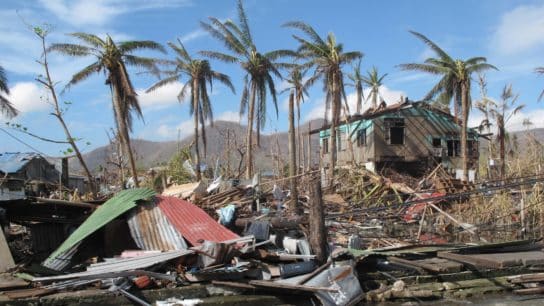Collective action is necessary to combat the effects of climate change and communication is key to building consensus and encouraging positive change. In order to address climate change as a collective, we must focus on changing our climate communication around difficult issues.
—
By now, many people are aware that greenhouse gasses (GHG) cause temperatures to rise around the globe, a process that has had a momentous impact on the environment within the last hundred years. Natural events and phenomena, such as volcanic eruptions, wildfires, and even animal respiration (breathing) are sources of various planet-warming gasses. However, industrialization and the continuous use of fossil fuels has significantly accelerated this process.
According to the Intergovernmental Panel on Climate Change’s (IPCC) 2023 Synthesis Report, human activities and interference, not limited to manufacturing practices, methods of transportation, and deforestation are largely responsible for the warming of the planet. Temperatures have increased 1.1C (33.98F) since the Industrial Revolution, leading to increasingly frequent and intense extreme weather events. Communities and wild habitats around the world have suffered the effects of these weather phenomena. According to the World Health Organization (WHO), pollution, extreme heat, and other extreme weather patterns pose a serious health threat to more than 3 billion people worldwide.
It is clear that climate change is an issue that has far reaching effects felt near and far, high and low. It is a universal concern that requires collective collaboration and cooperation toward finding solutions.
Nevertheless, with growing tensions within and between nations, it has become more of a challenge to find common ground when it comes to discussing topics such as climate change and reducing GHG emissions. These tensions are often intensified during discussions around critical issues such as climate change when miscommunication enters the equation. To bridge the communication gap on climate change and other environmental issues, we must understand how different interpretations of the same information impacts these interactions.
The Importance of Communication
The way we perceive and interpret information is largely influenced by our social surroundings. These social influences contribute to the development of our personal sense of identity, along with our attitudes and beliefs about issues like climate change. Political affiliation, culture, social class, religion, and field of work are not only aspects of our own personal identity, but are considered social groups that most of us belong to. We often surround ourselves with people who share these aspects of their sense of self in common. Since we are complex and multifaceted, we all belong to more than one group.
Climate change and policies aimed at reducing GHG emissions affect each group differently. Someone from a small community that is dependent on coal mining may resist policies aimed at reducing fossil fuel emissions out of concern for their community and livelihood. Religious beliefs can also impact one’s stance on climate change. For instance, some Christian denominations believe that a higher power is the primary source of weather patterns, while followers of nature-based religions may see addressing climate change as a spiritual obligation.
You might also like: Faith in Action: How Religious Communities Can Lead the Fight Against Climate Change
Attitudes around climate change and policies designed to address it are also largely influenced by political affiliation. For example, in the US, around eight in ten people who identify as Democrats believe that addressing climate change is a high priority, while only two and a half out of ten (one in four) Republicans agree with this sentiment. On a global scale, left-leaning individuals are more inclined to view climate change as a serious issue, however, the US seems to be the most politically divided on this issue compared to other nations, suggesting that nationality can also play a role in shaping our point of view.
Miscommunication often arises when our perceptions do not align based on the language we use to describe the same things. Arnold Schwarzanegger, an Austrian and American actor and former politician, made the headlines after pointing out a major flaw in the way we communicate about climate change:
“As long as they keep talking about global climate change, they are not gonna go anywhere. ‘Cause no one gives a s*** about that. So my thing is, let’s go and rephrase this and communicate differently about it and really tell people we’re talking about pollution. Pollution creates climate change, and pollution kills.”
Schwarzanegger has a point. It is a lot easier to be on the same page as others when we reframe our messages to reflect a more universal point of view.
A majority of people agree that pollution is hazardous to our health and the environment. The Yale Program Climate Change Communication found that 73% of Americans are aware of the health costs of pollution. While only a little over half of Americans were reported to be able to identify specific health conditions associated with fossil fuels, it is still clear that a majority of people are well aware of the health implications of pollution.
Just as writers must bear in mind the audience they are addressing, so must we when communicating with the intent to establish common ground on high-stakes issues. Facts and figures are important, and should not be discounted. However, most people are more receptive to things they associate with their everyday lives. Telling our neighbor who has an undying love for potatoes that the oceans are becoming more acidic from carbon dioxide might not be received as well as telling them that those brown spots they have been noticing on their favorite food are a collateral effect of climate change.
This can apply to most situations. Someone who enjoys wine might be more apt to act if they are informed that their favorite red is going to be harder to find in the next few years. Framing the way we communicate about climate change to match the interests and needs of the people we speak to is a powerful way to encourage collective action.
You might also like: Climate Change in Mexico Is Causing a Sriracha Shortage
Bridging The Gap on Climate Change Communication
Communication is something everybody does, every single day. It is a powerful tool when used responsibly. Changing our communication climate just might be the key to addressing climate change on a larger scale.
While we communicate differently across cultures around the world, there are some strategies everyone can start practicing today. Listen to other points of views. It is far easier to explain how climate change affects someone on a personal level if we listen. How would you know if your neighbor loved potatoes if you did not listen to them declaring their love for them? If we listen, we can learn about what is most important to others and when we speak to those things, people are more ready to listen to what we have to say. Asking questions is a great way to show that we are listening and that we are interested in what someone has to say. When someone is interested in what we have to say, it makes us feel heard and important, making it more likely for us to reciprocate what someone else has to tell us in return. Asking questions also helps us make sure we understand what is being said.
There are many resources available for those who are interested in improving their communication about difficult topics like climate change.
When discussing matters of this nature, it is easy to feel heightened emotions. It is important to remember to approach these matters with empathy and respect. While climate change can elicit feelings of fear, keeping the focus on solutions is more productive than focusing on things that are out of our control. Feeling motivated to make positive changes is difficult if hope is lost. We all have the power to influence others through communication. Let’s communicate our way to a better future for the planet we call home.
You might also like: The Importance of Environmental Education for a Sustainable Future














